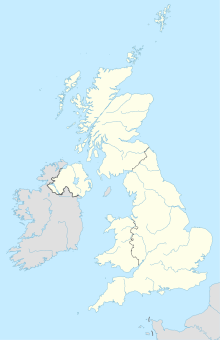Wisbech
Coordinates: 52 ° 40 ′ N , 0 ° 10 ′ E
Wisbech ['wɪzbit͡ʃ] is a small market and harbor town in the English county of Cambridgeshire in East Central England ( East Anglia ), near the coast of The Wash bay . It has 21,010 inhabitants (as of 2006) and belongs to the Fenland district . It is traversed by the Nene River, which has pronounced high and low tides due to the strong tides.
Origin of name
In the past, the place was significantly closer to the coast, which over the centuries has retreated further and further due to extensive drainage measures. Possible origin of the town name, the names of a "white beach" ( white beach ) or maybe "Ouse beach" (beach of now at Kings Lynn opens the River Great Ouse .)
history
The urban area of Wisbech was settled early by the Romans , who also left traces of their hydraulic engineering with the now accessible Roman Dyke . East England was later settled by Germanic tribes. After the conquest of England by the Normans (from 1066 ) a fortress was built here , from where attempts were made to fight the uprisings of the Anglo-Saxon population (Hereward the Wake). In 1478 a bishop's palace was built on the same site. The location of the large mansion, built in Regency style in 1816 , is still called " The Castle ". The surrounding Georgian development "The Crescent" still traces the outlines of the former moat of the original castle.
According to legend, the arrested parliamentary assassin Guy Fawkes was also imprisoned in the castle. He was taken through an underground tunnel to a pier on the nearby River Nene, from where he was taken by ship to his place of execution.
Drainage experts who had traveled from Holland gained a strong influence . In the course of the 16th and 17th centuries, with the help of windmills and dikes, they drained large parts of the previously swampy eastern English lowlands. A neighboring part of the country is still commonly referred to as "Holland", and the neighboring town of Spalding has long been a center of agricultural tulip cultivation.
Even today the area around Wisbech is characterized by fruit and vegetable cultivation , the black earth from the drained area is considered to be very fertile. For this reason, many companies that produced canned food settled in the early 20th century.
The port used to be of great importance for the import of timber from Germany and the Baltic region. In the meantime, attempts are being made to convert the port operations to tourism.
Attractions
In addition to the Georgian ensemble The Crescent , the Peckover House , which is inconspicuous from the outside , was built in 1722 by the Quaker Jonathan Peckover with beautiful gardens and has been the property of the National Trust since 1948 . Furthermore, the medieval church of St. Peter & St. Paul from the late 12th century with the crooked church tower. The Elgood brewery is known for its good beer. The Wisbech Castle has long served as a bishop's seat and now houses a training and education center.
Personalities
- William Godwin (1756–1836), is considered the founder of socialism and political anarchism
- Thomas Clarkson (1760–1846), fought for the abolition of slavery in the early 19th century ( Clarkson Memorial on the banks of the Nene)
- Octavia Hill (1838–1912), fought for better housing conditions for the poor at the end of the 19th century; Co-founder of the National Trust
- Agnes Metcalfe (1870–1923), British headmistress, writer and suffragette
- Harold Kroto (1939-2016), chemist
- Mike Stevens (* 1957), musician and music director ( Take That , 10cc ), songwriter , producer
- Jody Cundy (* 1978), athlete and multiple gold medalist of the Paralympics in swimming and cycling, world record in team sprint
Web links
Individual evidence
- ↑ cambridgeshire.gov.uk ( page no longer available , search in web archives ) Info: The link was automatically marked as defective. Please check the link according to the instructions and then remove this notice.
